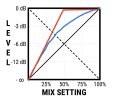Seven2Eleven
Inspired
Hey everyone,
I'm coming from the Helix world and I'm just trying to understand the mix laws for delays and reverbs in Fractal world.
So after reading the wiki and searching the forum, my understanding is that...
My question is why the different rules for delay and reverbs? They're both time based effects. Why can't they follow the same mix laws? And why 3 db specifically? Doesn't the dry level get lower and lower as raise the mix with reverbs? Wouldn't the higher mix mean you'd have to compensate more and more with the level?
Or maybe I'm misunderstanding something.
Any help would be appreciated. Thanks!
I'm coming from the Helix world and I'm just trying to understand the mix laws for delays and reverbs in Fractal world.
So after reading the wiki and searching the forum, my understanding is that...
- When running delays in series, the dry level stays constant with the mix between 0-50% and then decreases linearly to zero after. Consequently, there is no need to compensate for dry level with the level knob and can be left at 0 db when running in series.
- Reverbs on the other hand, don't behave this way. The mix knob actually decreases the dry level from 0-100% and therefore it's necessary to compensate by setting the level to +3 db when running in series. You can avoid this by running in parallel instead and running mix at 100%, use the input gain knob as an "fx send" or the level as an "fx return".
My question is why the different rules for delay and reverbs? They're both time based effects. Why can't they follow the same mix laws? And why 3 db specifically? Doesn't the dry level get lower and lower as raise the mix with reverbs? Wouldn't the higher mix mean you'd have to compensate more and more with the level?
Or maybe I'm misunderstanding something.
Any help would be appreciated. Thanks!


